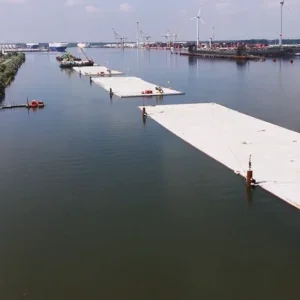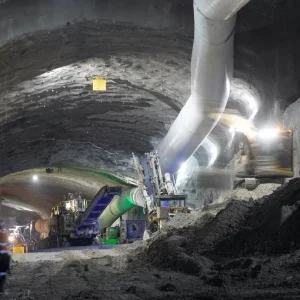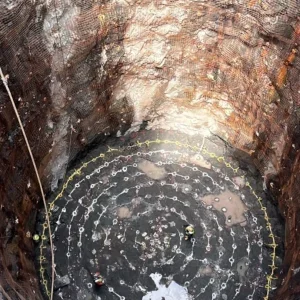Tracks, trails, paths, etched roads and all manner of routes have delicately laced over the foothills and higher reaches of mountain range throughout history, some fading from sight and use while others have grown in prominence and often lending a sense of permanence to the ebb and flow of trade and movement of people.
Yet, if it is the will of the waves of generations traversing the mountains that provides the impetus for forming trusted routes, then it is technology that affords the means of delivery, as ever. Civil engineering brings greater access to remote regions, taking ever more travellers both further and higher into the hills and more often.
These projects are often to be realised as tunnels, either longer than before or as the first to be bored in an area. But, while technology moves on, there is forever the challenge of geology and unpredictability of ground conditions.
In the Alps, the first of the gargantuan twin tunnels of the Gotthard rail tunnel in Switzerland is about to finish excavation, having deeply lanced through part of the range. Other projects are underway in the mountains to enhance the transport links of Europe, such as the more recent Ceneri, Brenner, Lotschberg, Lainzer and Lyon-Turin schemes. In South America, a variety of long transport tunnel projects are planned, including road and rail links through the Andes between Chile and Argentina.
While not on the scale of the transport tunnels in the Alps, among the many tunnelling schemes in the Himalayas there are three on opposite sides of the broad range—in India and China—that are major constructions and significant in their own right, in terms of scale and progress of tunnelling activity in the territories. They will help to deliver marked transport improvements for their local and national communities and the region.
Two of the projects—Rohtang Pass and Patnitop ridge road tunnels in northwest India—are short-cuts to be built at lower altitudes to help bypass the winding roads that snake up and over their respective mountains but become impassable for months in harsh winters. The tunnels, at comparable lengths of almost 9km, will deliver all-weather routes and so form reliable, important links.
The Guanjiao rail tunnel in Qinghai province in Western China is on the line that leads to Tibet. While this tunnel is very long and is being built to a large degree for the same purpose as the others—to avoid the gradual weaving climb up and down the mountain—there are two key differences: there is already a tunnel at the top of the climb and the line capacity is a bottleneck for the increased capacity needed on the Qinghai-Tibet line. For those reasons the new tunnel is being constructed.
Another difference for Guanjiao is that it is the only twin bore tunnel. While Patnitop will also have parallel tunnels, the second linked by a series of cross passages to the main road bore, is an escape tunnel. Rohtang, however, is a single tube and its provision for emergency safety space in a box tunnel that is constructed into and runs along the base of the bore.
While Guanjiao is being executed by two major Chinese contractors, the two tunnelling projects in India, Patnitop and Rohtang, are been undertaken by or significantly involve foreign contractors. Leighton is an engineering, procurement and construction (EPC) contractor on the Patnitop project and the contract award was announced mid-year. The tunneling work at Rohtang is being undertaken by Dywidag International leading a joint venture with local firm Afcons. The contract was awarded just over a year ago and excavation at the main, southern portal area, started last month.
As often discussed in the tunneling industry, there is an eternal debate on the merits of using drill and blast versus TBMs in the often faulted, fractured rocks in mountain regions along alignments with high overburden and the potential for squeezing ground as well as possibly mud and also groundwater difficulties. Site investigation for deep tunnels in those landscapes can be especially challenging, and difficult.
While having their different terrains, clients, procurement approaches, designs and sizes, the complicated geology of the Himalayas has seen the contractors for all three tunnel projects adopt drill and blast, the most common tunnelling technique used in the mountains.
As noted in the last issue of T&T Asia, however, and despite the setbacks some TBMs have had in Himalayan tunnelling— for projects in India, such as for the Dulhasti, Parbati II and Tapovan Vishnugad hydropower schemes, there is renewed interest in working with the excavation system—witness the Seli double shield for the Kishanganga power project. The machine has extra features designed to handle either weaker or squeezing ground and avoid being stuck and it is under assembly now in northwest India to bore the headrace tunnel.
But for now, and away from hydro, the efforts to improve transport links in mountains, such as at the Rohtang, Patnitop and Guanjiao projects, continues to most readily turn to the proven flexibility, adaptability and cost of the drill and blast technology. Some of the challenges on the projects are outlined in the features pages that follow.
Location map of three transport tunnel projects under construction in the area of the Himalayas Mountains, such as the lower parts of the Himalayas, present barriers that are drawing increasing numbers of tunnelling projects to help overcome and improve transport links







